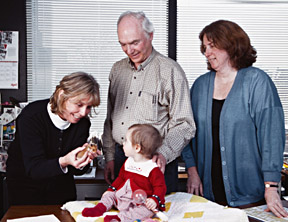From hamsters to humans, Cornell neurobiologists' brain-development timeline finds many parallels – and a few curious exceptions
By Roger Segelken

A team of Cornell neurobiologists has modeled key milestones in brain development across nine mammalian species, from hamsters to humans. They have, for example, pinpointed the date after conception when the cells that make up the retina of the eye are formed. The neurobiologists found pretty much what they expected -- an evolutionarily conserved pattern of sequence and timing. But they also found a few curious exceptions, such as the discovery that the human brain is relatively developed at birth.
Knowing precisely how development in rodent brains can be translated to other species, the researchers hope, might reduce the number of higher animals required for research and should make transgenic mice an even more valuable animal model in biomedical research. And because brain (neural) development milestones are remarkably consistent in mammals, the researchers' mathematical model is able to fill in the blanks in one species, Homo sapiens , where experimentation is unthinkable.
One product of the model -- 95 neural development milestones for hamsters, rats, mice, spiny mice, ferrets, cats, monkeys and humans -- is reported in the July 2001 issue of Neuroscience (Vol. 105/1, pp. 7-17) by Barbara Clancy, Richard B. Darlington and Barbara L. Finlay of Cornell's Department of Psychology.
"We're happy that this model will improve estimation of the timing of milestones in brain development, particularly for humans," says Clancy, a postdoctoral associate in biopsychology. "This also should permit data on the well-studied rat to be applied to the recent burst of genetic studies in mice. The model works because of the striking stability in the order and relative timing of neural events across many mammalian species, including human infants. Although their rather unwieldy bodies might disguise it, the model shows that the brains of human infants are relatively developed at birth. This legitimizes something that many new parents have bragged about all along -- their baby really is quite precocious." However, Clancy says, "we're a little disappointed that some events we humans think are important just don't fit. We hoped we could use the mammalian model to advise when humans should wean their young but no such luck. If humans followed the time course set by brain development, we would wean our young immediately after birth, and of course our kids have other ideas."
The "weaning problem" is likely related to another peculiarity in mammalian development, Clancy notes: Relative to the sequence of neural development events, the times required for gestation and dates of birth are "all over the map, or rather, all over the calendar." Some kinds of mammals are born with their eyes open, while others can't open their eyes until hours or days after birth, she says, citing an example familiar to anyone who has raised babies and kittens.
The only other event that doesn't fit the developmental patterns, the Cornell neurobiologists report, is a huge surge in the production of synapses (the junctions where brain cells communicate), an event that begins just before birth in the developing brains of primates, including humans.
For all other milestone events, the model accurately "predicted" the post- conception (PC) time, where the PC time was known from actual experiments with animals. (Accurate prediction of known facts is a critical test for mathematical models. The model's correlation, between predictions and known facts, was 0.9900, a nearly perfect relationship that indicates high accuracy.) For example, the PC time of peak development of the amygdala (the almond-shaped section in the front of the brain's temporal lobe that is involved in emotions such as fear) was predicted by the Cornell model to be 14.3 days in rats, whereas previous experiments put amygdala development at 15 days. Similarly accurate predictions were found for amygdala development in two other thoroughly studied species, mice and macaque monkeys.
And for species with no experimental data on that part of the brain (including hamsters, rabbits, ferrets, cats and humans) the model made predictions, based on the general developmental pattern in all mammals. Thus, the PC time of peak amygdala cell development in the human fetus should be about PC 50 days, according to the Cornell model -- although no ethical scientist would ever conduct experiments to confirm that prediction.
"That's the beauty and power of statistical science," Darlington says. "Because the sequence and timing pattern of neural development has been conserved throughout the evolution of mammals, no animals were sacrificed to compile this data. This model could very well result in fewer animals being used in research, and human experimentation will not be needed to increase our understanding of events in our own neural development that we need to know about." The new model is an outgrowth of a mathematical equation first determined and reported in 1995 by Darlington, a behavioral statistician and professor of psychology, and Finlay, professor and chair of the Cornell Department of Psychology. Now the model can be used by any neuroscientist to extend predictions of neural development milestones to any other mammalian species.
The study was supported by a grant from the National Institutes of Health and a postdoctoral research fellowship from the National Institute of Mental Health.
"Sorry, we just can't use this model to settle the perennial question: How old is that dog in people years?" Finlay says. "But if you give us a minute, we can tell you exactly when a fetal dog's amygdala appears."
Related World Wide Web sites:
- Neuoscience journal: http://www.elsevier.com/locate/neuroscience
Media Contact
Get Cornell news delivered right to your inbox.
Subscribe